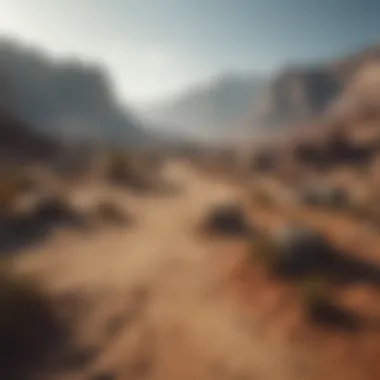Analyzing the Appeal of Sandbox Zombie Games


Intro
The world of video games has seen vast evolutions, genres rising and falling like the tides. Among these, sandbox zombie games have carved out a niche that attracts a dedicated following. This sub-genre melds the chaotic thrill of survival horror with the limitless creativity of sandbox mechanics. Gamers can build, craft, and survive amid an ever-present threat, creating tension that fuels countless hours of gameplay.
In this article, we’ll take a comprehensive look at the mechanics that make these games so compelling. We’ll explore how player agency plays a critical role, the dynamics of community engagement, and the design elements that set these games apart from traditional survival horror experiences. The discussion will include notable game titles, current trends, and projections for the future of sandbox zombie games. By the end, you’ll understand not just the 'how', but also the 'why' behind their stunning popularity.
Overview of Sandbox Zombie Games
Sandbox zombie games invite players into vast worlds rife with peril and possibility. Unlike linear games with strict narratives, these allow for exploration and innovation. Titles like Minecraft and 7 Days to Die exemplify this freedom; players are not just surviving zombies—they are crafting tools, building shelters, and exploring the unknown.
This genre fundamentally blurs the lines between creativity and survival. Players are faced with open-ended environments that encourage experimentation. They gather resources, fend off zombie hordes, and sometimes collaborate with others, all while influencing the world around them. By design, these games foster both anxiety and excitement—players must keep their wits about them, all while seizing every opportunity to build and create.
Gameplay Dynamics
Player Agency
A defining characteristic of sandbox zombie games is player agency. Gamers can make choices that genuinely affect the game world and their experience within it. The sheer magnitude of options—where to build, what to create, whom to ally with—ensures that no two playthroughs are identical. Players often share strategies and creations, significantly amplifying the community aspect.
Community Engagement
Many sandbox zombie games foster vibrant communities. Forums on sites like reddit.com bristle with discussions about best practices for survival, unique builds, and even fan art. This engagement can lead to collaborative gameplay or competitions, enriching the overall experience.
Visuals and Effects
Aesthetic Appeal
The visual art in sandbox zombie games is as crucial as the gameplay. Styles vary widely—from the blocky, pixel-art charm of Terraria to the graphic realism of Days Gone. Each visual approach serves a purpose, enhancing immersion or providing a stark contrast to the grim survival themes.
"Visual storytelling plays a pivotal role in captivating players, drawing them into the haunting worlds these games create."
Players often connect emotionally with their environments. Whether it’s the desolate landscapes dotted with abandoned structures or lush forests harboring hidden dangers, visuals breathe life into the game.
Closure
This comprehensive analysis of sandbox zombie games highlights the interwoven elements that form their appeal. In a realm where creativity meets survival, players enjoy the dual thrill of building and safeguarding their worlds. With t he community echoing their successes and failures, the narrative grows richer, promising a bright, albeit uncertain, future for this unique genre.
Prologue to Sandbox Zombie Games
As the gaming industry evolves and players seek more immersive experiences, sandbox zombie games have emerged as a fascinating intersection between creativity and survival. This genre empowers players to mold their environments while combating the relentless threats posed by the undead. Not only have these games carved out a niche within the gaming realm, but they have also sparked significant discussions about player autonomy and community interaction.
Defining the Sandbox Genre
The sandbox genre is often characterized by open-world gameplay, where players have the freedom to explore vast terrains and interact with a plethora of objects and systems. Imagine wandering through a desolate landscape, chock-full of abandoned structures and resources, with no linear path compelling you forward. You carve your own journey, choosing when to scavenge, when to build, or when to engage in combat. This fluidity allows players to experience stories that resonate with their personal play styles. In short, it's a world where every crumbling brick can be a vital resource or a dangerous trap.
Characteristics of Zombie Games
On the other hand, the zombie game component introduces a unique set of mechanisms that thrill players. From the pervasive sense of dread to the survival instincts that kick in at the slightest sound, these games often play on pathways of survival. Players must expertly manage their health, ammunition, and environment to escape the gnashing jaws of the undead. Each encounter isn't just about pulling a trigger; it’s about knowing when to fight, when to flee, and how to manipulate the terrain to your advantage. Here are a few key features that define zombie games:
- Survival Elements: Food and resource scarcity create tension, forcing players to make tough choices.
- Evolving Challenges: Threats grow more complex, introducing new enemy types or environmental hazards as your skills improve.
- Atmospheric Settings: Dread-inducing music and eerie silences cultivate an immersive atmosphere that keeps players on edge.
These aspects blend seamlessly within the sandbox framework, offering numerous layers to engage with, making it easy to see why players are drawn to these hybrid games. Whether it's building a safe haven or exploring a haunting landscape riddled with challenges, the combination of sandbox dynamics and zombie threats provides a compelling experience that players can tailor to their preferences.
The Appeal of Sandbox Zombie Games
The allure of sandbox zombie games lies in their profound capacity to combine freedom with chaos. It’s a genre that invites players to shape their own experiences amidst a backdrop of despair. By allowing creativity to flourish in an open-world environment, such games cater to the player's desire for agency, a characteristic that enhances their overall enjoyment.
Player Agency and Freedom


When you step into the world of sandbox zombie games, you're no longer just a passive participant. Instead, you are given the steering wheel; your choices dictate not just your survival but also the path the storyline will take. This element of agency transforms gameplay into a personal experience. For instance, think about a game where you can decide whether to build a fortified base, scavenge for supplies, or forge alliances with other players. Each choice you make has implications, influencing both your immediate environment and long-term survival.
With this freedom, players can adopt various play styles. Some may prefer stealthy approaches, sneaking around to avoid hordes of the undead, while others might revel in all-out assault, facing challenges head-on. This layer of personal strategy yields a myriad of unique gaming experiences, reminding us that no two players will ever navigate the same path in a sandbox zombie environment.
Creativity and Customization
Creativity runs amok in sandbox zombie games. The ability to customize your character, your gear, and even your base allows players to express themselves uniquely. It's akin to an artist with a blank canvas. There are numerous ways to tackle the intricacies of survival, and this fosters a genuine sense of ownership over one's journey. The choice of weapons—whether you forge makeshift tools from scrap or find rare firearms—adds another layer of customization.
Moreover, building shelters from scratch or modifying existing structures touches on creative problem-solving. Players often share their creations, exchanging ideas and strategies with one another, which nurtures a robust community spirit.
"Customizing your in-game world is just as essential as the survival mechanics themselves; it’s about leaving your mark in a universe filled with zombies."
Exploration and Discovery
Exploration in sandbox zombie games encourages a thirst for discovery. The expansive environments are often teeming with secrets: abandoned vehicles, hidden caches, and survival kits tucked away in remote corners. Each foray into the wilderness can yield valuable items or uncover the dark narratives embedded within the world. This might mean stumbling upon a deserted town that tells its own story through the remnants left behind.
Players are also compelled to navigate diverse terrains, from urban ruins to dense forests, each offering unique challenges. The thrill of being the first to uncover a new area or resource is a rewarding experience that builds excitement and fosters curiosity. It encourages players to push boundaries, venture into unknown territories, and embrace the risk that comes with exploring an unpredictable environment.
In summary, the appeal of sandbox zombie games is grounded in the intertwining elements of player agency, creative expression, and the excitement of exploration. This combination creates a rich gaming tapestry that attracts a dedicated player base and fuels a thriving community.
Key Features of Sandbox Zombie Games
The realm of sandbox zombie games distinguishes itself through a blend of thoughtful design elements that not only enhance the gaming experience but also engender a strong sense of immersion. These key features serve as the backbone of what makes the genre compelling. Players engage with these elements, weaving their own narratives amid the chaos of a zombie apocalypse. Let’s dissect the major attributes that characterize sandbox zombie games, ensuring a thorough understanding of their significance.
Open World Design
Open world design is like a sprawling canvas, giving players the freedom to explore at their own pace. In these virtual environments, you’ll find vast landscapes populated with remnants of civilization and untamed wilderness. Forests, urban centers, and dilapidated structures set the stage for adventures that are born from curiosity.
In sandbox zombie games, the stakes are high, as the zombies aren't just mindless creatures; they roam freely, adapting and responding to player actions. This unpredictability creates an atmosphere of suspense. No two situations are alike, and each corner turned might lead to either treasure or a threatening horde.
The layout of the open world often encourages players to travel off the beaten path. Many find themselves clambering through abandoned buildings, rummaging for supplies, or scouting areas for safe havens, which can be more rewarding than sticking to the same routine. In this way, the open world acts as a playground, affording a sense of exploration that is both exhilarating and terrifying.
Resource Management
Resource management is a critical component of survival gameplay within sandbox zombie environments. Players must juggle limited supplies, constantly weighing the benefits of using a valuable resource against the risks of facing zombies without it. Each item can mean the difference between life and death.
Think of it as a chess game against time and resource scarcity. Whether it’s food, weapons, or building materials, decision-making becomes imperative. For instance, you might have a stash of food that replenishes health but could be valuable for trading with other players. The struggle lies in prioritizing what is truly necessary and resisting the impulse to hoard.
Resource management also fosters a community dynamic. Players often share information about resource-rich areas, thereby encouraging cooperation. This adds a layer of strategy to the whole experience.
Crafting Systems
Crafting systems in sandbox zombie games allow players to unlock their inner survivalist. With a well-implemented crafting mechanic, players collect raw materials to create essential tools, weapons, or even shelter. The process of transforming a handful of scrap metal into a makeshift weapon exemplifies human ingenuity in desperate situations.
For instance, imagine scavenging through a rundown garage discovers a few old pipes and a box of nails. These materials can be combined to fashion a rudimentary weapon, ensuring survival in hostile circumstances. Players often delight in experimenting with combinations to discover unique items or enhance their existing gear.
Crafting introduces another layer to gameplay, making players feel like they're actively shaping their environment, rather than passively experiencing it.
Combat Mechanics
Combat mechanics play an integral role in defining the experience in sandbox zombie games. Unlike linear shooter games, combat in sandbox settings demands a more tactical approach. Players must consider numerous factors, such as stamina, sound, and weapon effectiveness.
Engaging a zombie horde requires strategic thinking; one might opt for stealth to evade detection or go in guns blazing depending on their inventory. Different weapons offer varying benefits, and knowing when to retreat is often as crucial as knowing when to attack.
As players level up, they may receive skills that enhance their combat efficacy, leading to deeper personalization of play style. Successful navigation of combat scenarios requires a keen awareness of the risks and rewards involved.
"In sandbox zombie games, players are constantly challenged to adapt, as the undead are just as unpredictable as they are relentless."


Community and Multiplayer Elements
Sandbox zombie games thrive on community and multiplayer dynamics, offering players a rich tapestry of shared experiences that elevate the gaming experience. Unlike traditional games that often isolate players within their own worlds, these games encourage collaboration and competition, creating a vibrant ecosystem that keeps players engaged. The attraction of providing both cooperative efforts and competitive scenarios leads to deeper interactions and a more connected gaming community. As such, understanding these elements is crucial for grasping what makes sandbox zombie games uniquely appealing.
Cooperative Gameplay
Cooperative gameplay stands out as a core element in the sandbox zombie experience. Players often band together to survive in treacherous environments, pooling their resources and skills. The ability to strategize collectively to fend off wandering zombies, gather supplies, and build shelters offers an enriching layer of gameplay.
In practice, when players form a team, they can tackle challenges that would be insurmountable alone. Whether it’s facing a horde of the undead or navigating treacherous terrain, cooperation can lead to successful outcomes. For example, in a game like 7 Days to Die, players can create intricate bases and defend them against waves of zombies together, making the feeling of accomplishment collective rather than individual.
Cooperation also fosters a sense of community. Players become more invested in one another’s success, often leading to player friendships that last beyond the game. This bonding highlights how sandbox games can produce more than just entertainment; they can cultivate genuine connections among players.
Competitive Modes
While many players enjoy the camaraderie found in cooperative gameplay, competitive modes introduce a thrilling edge to the experience. Players can engage in various challenges, either against each other or in rival teams, which fuels a spirit of competition. Environments designed for PvP (player versus player) battles can present unique survival scenarios where quick-thinking and skill are essential.
For instance, Dead by Daylight does this terrifically well, where players either take on the role of the killer or survivors, leading to strategic gameplay that demands both teamwork and personal skill. Each player's success hinges on both their tactical choices and their ability to outwit opponents. This makes every encounter a chance to learn and adapt, enhancing the gameplay loop.
Competitive modes can also redefine dynamics by allowing for leaderboard systems, in-game tournaments, or time-limited challenges. With rewards on the line, players are more likely to engage deeply, leading to higher retention rates and community discussions regarding strategies and techniques.
Community Modding and Content Creation
Another fascinating aspect of sandbox zombie games is their strong modding communities. Players are not just participants; they become creators. Through modding, they can alter aspects of the game — from textures and character designs to entire new gameplay mechanics. Titles like Minecraft or The Walking Dead: Saints & Sinners have thriving modding scenes that empower players to express their creativity and introduce fresh elements into the gaming world.
This ability to tinker and modify games builds a sense of ownership. Players contribute to the narrative and world-building, enhancing the longevity of the game itself. It's as if each player can etch their mark on the canvas of the game, resulting in a patchwork of experiences that differ widely across the community.
Community-created content can also include everything from maps to scenarios that can broaden gameplay horizons. Looking to platforms like Reddit, players share their latest mods, offering support and suggestions on how to enhance others’ creations. Here, the spirit of collaboration meets innovation, pushing the boundaries of what players can expect from their gaming experiences.
"The strength of any sandbox zombie game lies in its community. The multiplayer aspect isn't just a feature; it's the very heartbeat of the genre, making every play-through uniquely exciting."
In summary, the interwoven elements of community and multiplayer make sandbox zombie games compelling. They not only provide a rich playground for individuals to survive but also nurture collaborations and healthy competition among players. These dynamics ultimately enrich the gaming experience, laying a solid foundation for future developments in the genre.
Notable Sandbox Zombie Game Titles
Within the fascinating realm of sandbox zombie games, there are standout titles that have shaped not only player experiences but also the genre itself. Notable games serve as benchmarks, showcasing innovative gameplay mechanics, resource management strategies, and community aspects that provide insights into the evolution of sandbox gameplay. By exploring these titles, players and developers alike can gauge what works, what resonates, and what might come next in this riveting genre.
Game One: Overview and Impact
Let’s start with Minecraft: Story Mode – Season 2. Although it is primarily known as a crafting and building game, its narrative-driven approach intertwined with elements of survival horror captures the essence of zombie games. The inclusion of zombie mobs in multiplayer scenarios allows players to experience both cooperation and chaos.
The impact of this title can’t be understated. It highlighted the narrative potential within sandbox gameplay. Players are not just crafting and building; they engage in a storyline rich with decision-making. Many gamers appreciate how it showcases the tension of survival. The mechanics of gathering resources to fend off waves of zombies foster a sense of urgency that keeps players on their toes. Additionally, mods like the Zombie Apocalypse create variations that bring fresh life into the game, proving how adaptable it is for differing gameplay preferences.
Game Two: Overview and Impact
Next up, we have 7 Days to Die. This title perfectly marries open-world exploration with brutal zombie combat. The game ingeniously mixes tower defense with survival elements, pushing the player to build fortifications while scavenging for resources. The learning curve is steep but rewarding.
One significant aspect is the time-limited horde mechanics, where players are faced with increasing waves of zombies every seventh day. This structure has led to deep strategic planning; players often spend days preparing their defenses to make it through the onslaught. The impact of this title lies in its community-driven content and versatility—it encourages co-op gameplay while allowing solo missions, proving a flexible sandbox environment that is truly engaging. As players share strategies on platforms like Reddit, they build a rich narrative community around the challenges presented.
Game Three: Overview and Impact
Lastly, let’s talk about DayZ. Originally a mod for ARMA 2, this title has changed the landscape of sandbox zombie games dramatically. It emphasizes realism and player interaction, making survival a tense yet thrilling experience.
DayZ excels in creating an atmosphere where every encounter can lead to danger. Players must navigate not just the environment but the other players, which heightens the dynamics of survival horror. As they search for food, weapons, and shelter, there's a constant awareness of threats—all the while facing a relentless horde of zombies. This title's impact is monumental for the genre; it shaped expectations around player interactions in open-world designs. Players often recount tales from their in-game journeys, enriching the storytelling potential within these environments.
Each of these notable games contributes to a fuller understanding of sandbox zombie games by showcasing various approaches to gameplay mechanics, community engagement, and narratives. They are not just games but platforms for creativity, experimentation, and, most importantly, survival.
Trends in Game Development


The landscape of game development is constantly evolving, and sandbox zombie games are not exempt from these sweeping changes. This section aims to elucidate the significance of current trends, focusing on how technological advancements and shifts in player expectations shape the gaming experience. Understanding these elements not only enriches the player's journey but also keeps developers on their toes when creating immersive environments.
Technological Advancements
In today's world, technology advances at a breakneck pace, and gaming is a prime beneficiary of this evolution. Several key technologies have propelled sandbox zombie games into a new era. Virtual reality (VR), augmented reality (AR), and cloud gaming are just a few examples that have altered how players interact with their virtual worlds.
- Virtual Reality: While VR is still on the fringes of mainstream gaming, its potential is untapped in the realm of sandbox zombie games. Imagine donning a headset and feeling the sweat drip down your forehead as you fend off a horde of flesh-eaters in real-time. The immersion level could reach heights previously thought unattainable.
- Realistic Graphics: Game engines like Unreal Engine and Unity now offer stunning visuals that transport players into chilling atmospheres filled with zombies. The creeping dread of an approaching undead can be felt more intensely when rendered with photorealistic graphics.
- Artificial Intelligence: Another key area of focus is AI which shapes how zombies interact with players. These mindless beings can appear more calculated, predictable, or even cunning, depending on the programming.
These advancements not only enhance gameplay experience but also encourage deeper engagement. A player’s journey is further enriched as they navigate a world that feels alive, unpredictable, and sometimes terrifying.
Shifts in Player Expectations
Gone are the days when merely surviving against zombies was sufficient. Today's players expect a multi-faceted experience that caters to their creativity and personal playstyle. As the industry matures, the checklist of desires from gamers has expanded to include unique elements that enhance their satisfaction.
- Narrative Depth: Players are increasingly drawn to immersive stories. They want lore that resonates and characters that evolve beyond mere survival mechanics. The ability to shape one's narrative through choices in-game adds layers of engagement.
- Social Interaction: With the rise of community-focused gaming, players now anticipate opportunities for collaboration and competition. Sandbox zombie games often foster environments where cooperation can mean the difference between survival and demise. This social dimension has become fundamental for many players.
- Customization and Personalization: Users seek the ability to tailor their experience to their liking. The freedom to customize avatars, gear, and even entire environments is a sought-after feature.
The modern gamer craves not just survival but a fully embodied experience, one where their choices and creativity can flourish.
In summary, the trends in game development reflect a broader evolution in the gaming culture. As technology enhances the possibilities for storytelling and interaction, player preferences shift, demanding innovative solutions to satiate their zombie-slaying cravings. This dynamic interplay between tech and expectation will undoubtedly define the future of sandbox zombie games.
The Future of Sandbox Zombie Games
As we look forward in the evolving landscape of sandbox zombie games, it's crucial to recognize the pivotal role they will continue to play in the gaming industry. The unique blend of open-world mechanics and survival strategies set within a zombie apocalypse not only captivates players but also raises significant questions about the direction of game development. Understanding the future of this genre means diving into emerging technologies and the boundless potential for innovation.
Emerging Technologies
Technological advancements are reshaping how games are developed and experienced. In sandbox zombie games, innovative technologies are on the brink of altering gameplay dynamics considerably. For instance, the integration of virtual reality (VR) and augmented reality (AR) holds promise for immersive experiences that heighten the sense of realism and urgency. Imagine navigating through a zombie-infested wasteland using VR goggles, where every sound, shadow, and movement feels lifelike.
Furthermore, advancements in AI can lead to more intelligent and adaptive enemy behavior. This not only challenges players but enriches the gameplay. Instead of predictable zombie patterns, players might encounter foes that learn from their strategies, adapting and responding in ways that keep the thrill alive. The potential for procedural content generation—where environments and quests are dynamically created—could also expand the gameplay possibilities significantly, resulting in fresh experiences each time a player logs in.
The advent of cloud gaming technologies can make these advancements more accessible. Players might enjoy high-quality gameplay without the need for expensive hardware. By leveraging the cloud, developers can push the boundaries of visual fidelity and vast open-world designs, allowing for ever more intricate game worlds.
"The next wave of gaming is upon us, and the innovations in technology will pave the way for an even richer sandbox experience."
Potential for Innovation
The potential for innovation within sandbox zombie games appears boundless. As developers experiment with storytelling mechanics, we may begin to see narratives that are not only engaging but also non-linear. Players could influence story outcomes through their choices and actions in real-time, leading to multiple possible endings. This shift from linear storytelling to a more interactive narrative could result in a level of player engagement not previously experienced.
Customizable multiplayer options are another key area ripe for exploration. Games where players can create their own shared worlds with friends or use community-designed elements add layers of creativity and originality to the game experiences. This could lead to unique gameplay scenarios, where different groups approach challenges in entirely different ways. The sandbox genre's innate emphasis on player agency makes it the perfect vehicle for these innovations.
The Path Ahead
Ultimately, the future of sandbox zombie games rests upon a foundation of community innovation and technological excitement.
- Enhanced AI for interactive gameplay.
- Immersive VR/AR experiences for realism.
- Procedural content generation for endless variability.
- Dynamic storytelling for player-driven narratives.
- Cloud gaming for accessibility and quality.
As these elements converge, we are likely to witness an unprecedented evolution of the sandbox zombie genre. Players will find themselves not just surviving, but truly living within the game. The next evolution in this genre promises to be as dynamic and diverse as the community that drives it.
End
The conclusion plays a crucial role in synthesizing the information laid out throughout this exploration of sandbox zombie games. It serves as a final checkpoint, allowing readers to reflect on the nuances of the genre. In the world of gaming, where trends shift faster than the blink of an eye, understanding the core aspects of sandbox zombie games becomes indispensable for enthusiasts and developers alike.
Recap of Key Points
Throughout the article, we have traversed various facets of sandbox zombie games. Here’s a recap of key takeaways:
- Sandbox Genre Defined: We started by establishing the sandbox genre, reminding us that player freedom and creativity are at the heart of these games.
- Appeal Overload: Player agency and opportunities to innovate and explore draw gamers in, creating a compelling dynamic that keeps engagement high.
- Features & Mechanics: Discussing key features such as open world design and crafting systems highlighted the depth these games offer.
- Community Interactions: The role of multiplayer aspects has become significant, shaping the gaming experience into something more collaborative.
- Trends and Innovations: Lastly, we looked ahead to future possibilities, emphasizing how emerging technologies could reshape the landscape.
By summarizing these points, we underscore the unique standing sheets of the sandbox zombie genre in modern gaming culture.
Final Thoughts on the Genre
Diving into the sandbox zombie game arena reveals a rich tapestry of gameplay elements, community involvement, and creativity. This genre stands out from other types due to its inherent flexibility, allowing players not just to fight for survival but to redefine what gaming experiences might entail.
There is something captivating about challenging oneself in vast worlds filled with zombies, where every choice boils down to survival and strategy. The potential for storytelling is vast and uneven, enabling players to carve out unique narratives in spaces that are entirely their own. As technologies evolve, we can expect sandbox zombie games to innovate even further, paving the way for experiences that are immersive and engaging.















